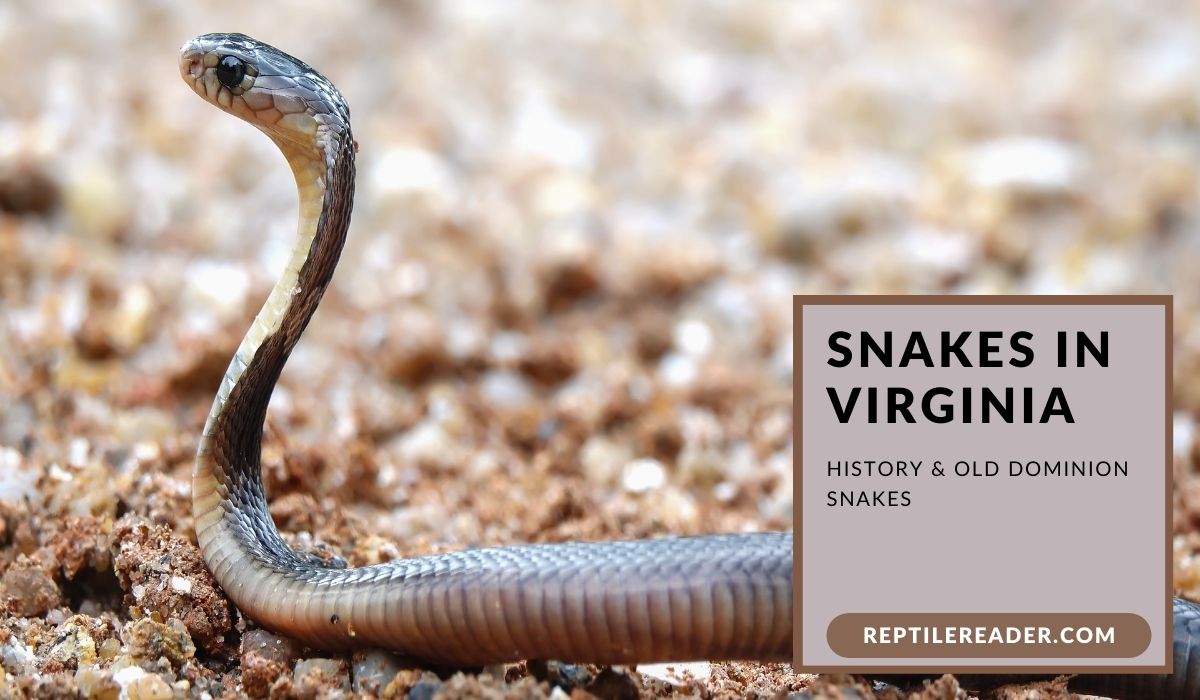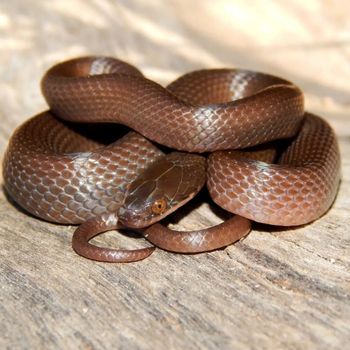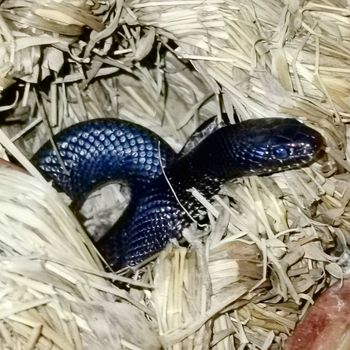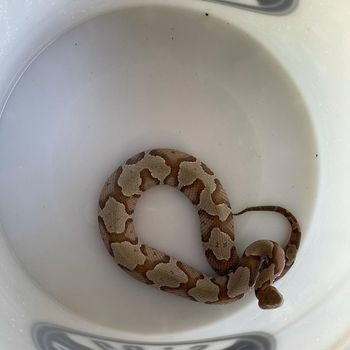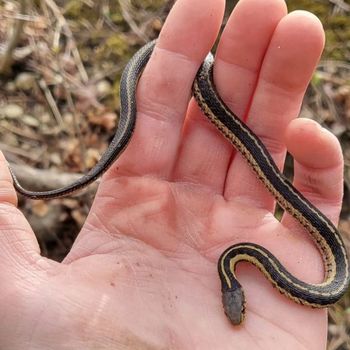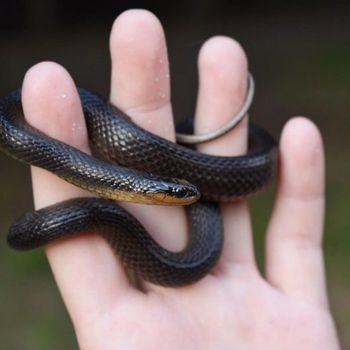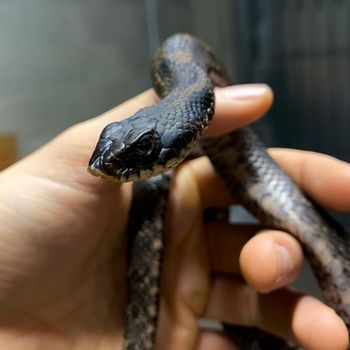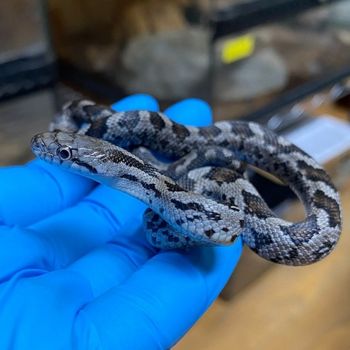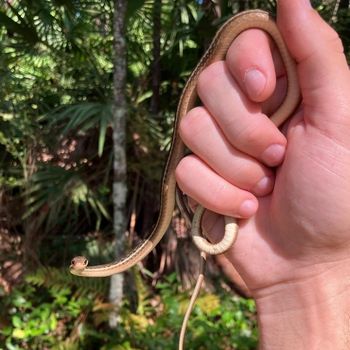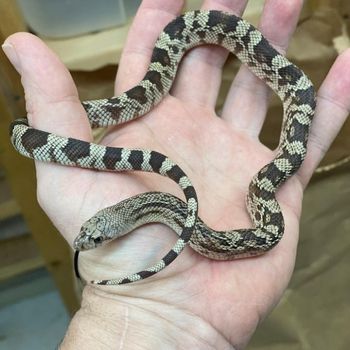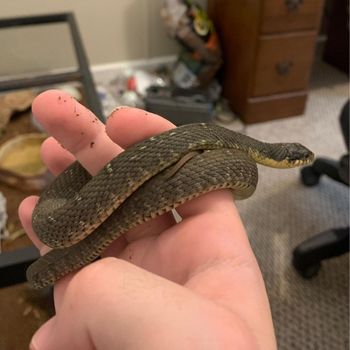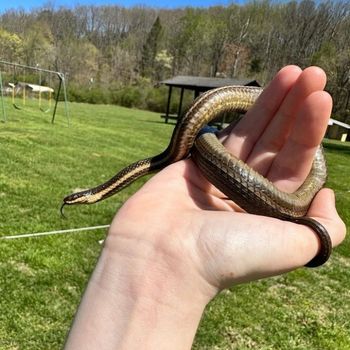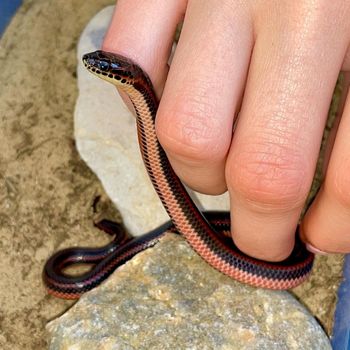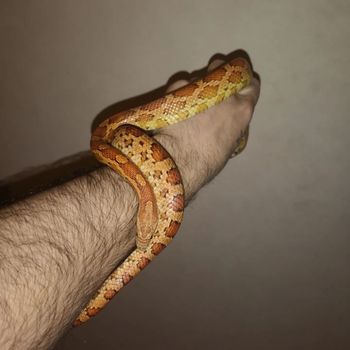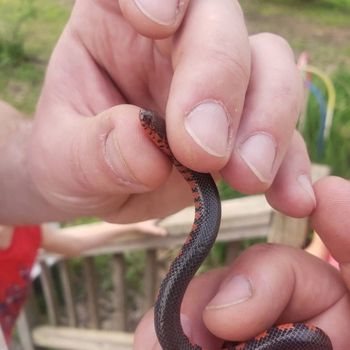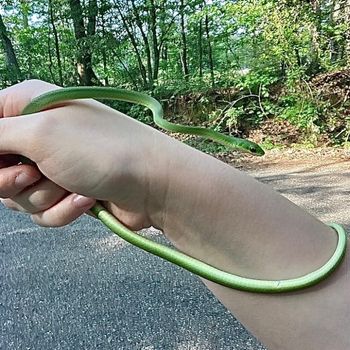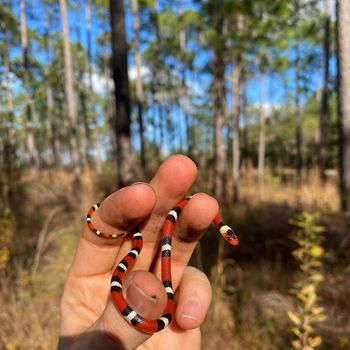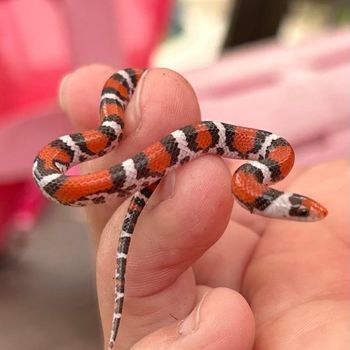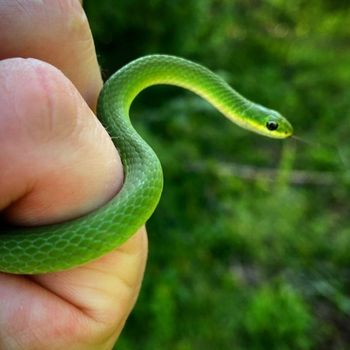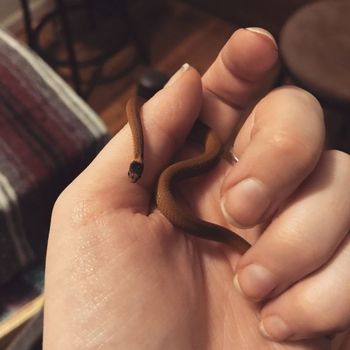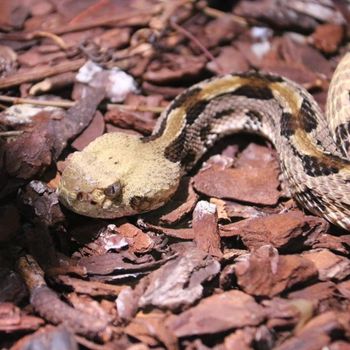Snakes in Virginia: History & Old Dominion Snakes
We all know that Virginia is a haven for a variety of fascinating wildlife, and with its forests, wetlands, and mountains, it’s no surprise that our beloved slithery friends are abundant here. But did you know that there are actually 25 different species of snakes that call Virginia home?
That’s right! From venomous pit vipers to colorful and harmless little garden snakes, there are plenty of opportunities in Virginia for snake lovers to catch a glimpse of these fascinating creatures.
So, what are you waiting for? Grab your camera, some good field guides, and maybe a herpetologist buddy, and let’s explore the dazzling diversity of Virginia’s snakes together.
| # | Name | Details | Image |
| 1 | Brown Water Snake (Lycodonomorphus rufulus) |
| 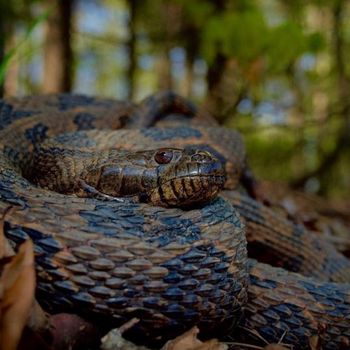 |
| 2 | Dekay’s Brownsnake (Storeria dekayi) |
| 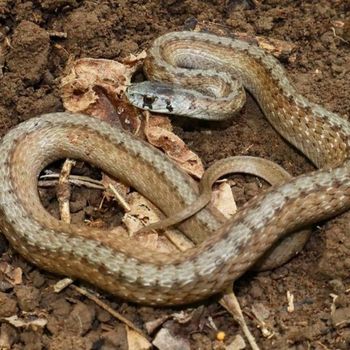 |
| 3 | Eastern Black Kingsnake (Lampropeltis nigra) |
| 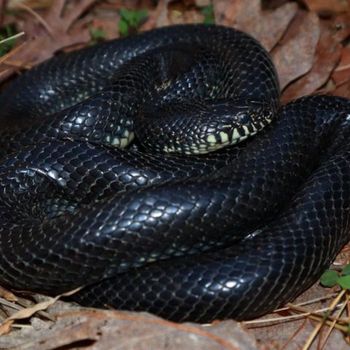 |
| 4 | Eastern Copperhead (Agkistrodon contortrix) |
| 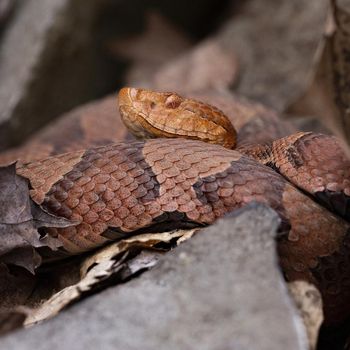 |
| 5 | Eastern Garter Snake (Thamnophis sirtalis sirtalis) |
| 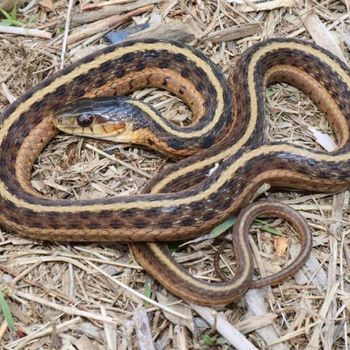 |
| 6 | Eastern Glossy Swamp Snake (Miriamausia oligospila) |
| 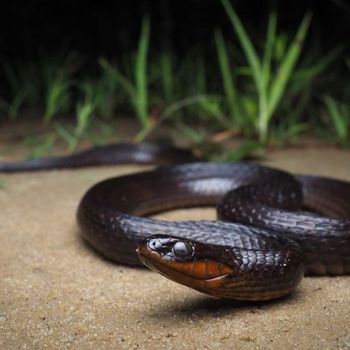 |
| 7 | Eastern Hog-nosed Snake (Heterodon platirhinos) |
| 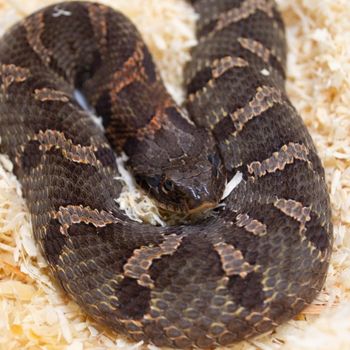 |
| 8 | Eastern Kingsnake (Lampropeltis getula) |
| 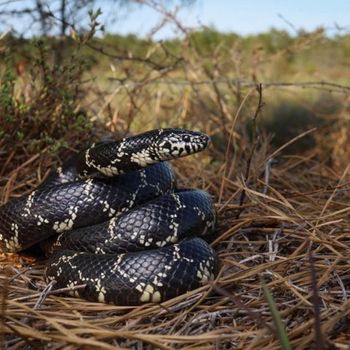 |
| 9 | Eastern Milksnake (Lampropeltis triangulum) |
|  |
| 10 | Eastern Rat Snake (Pantherophis alleghaniensis) |
| 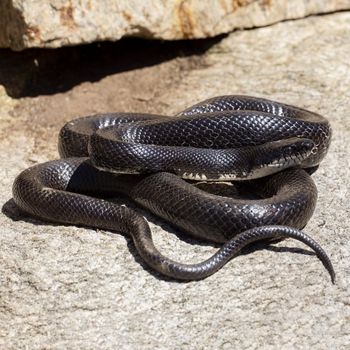 |
| 11 | Eastern Ribbon Snake (Thamnophis sauritus sauritus) |
|  |
| 12 | Northern Cottonmouth (Agkistrodon piscivorus) |
| 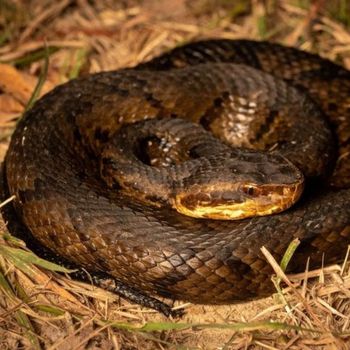 |
| 13 | Northern Water Snake (Nerodia sipedon) |
|  |
| 14 | Pine Snake (Pituophis melanoleucus) |
| 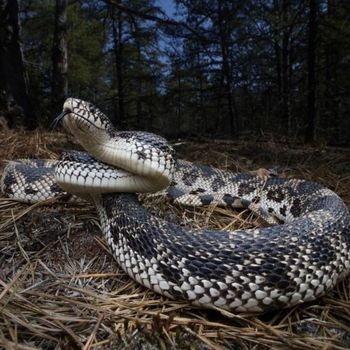 |
| 15 | Plain-bellied Watersnake (Nerodia erythrogaster) |
| 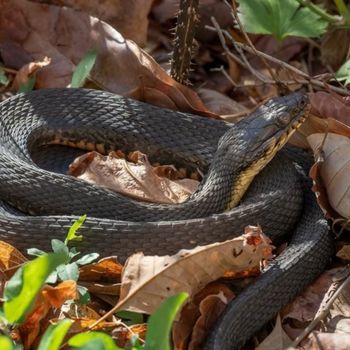 |
| 16 | Queen Snake (Regina septemvittata) |
| 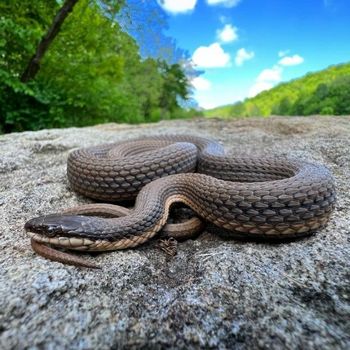 |
| 17 | Rainbow snake (Farancia erytrogramma) |
|  |
| 18 | Red Corn Snake (Pantherophis guttatus) |
| 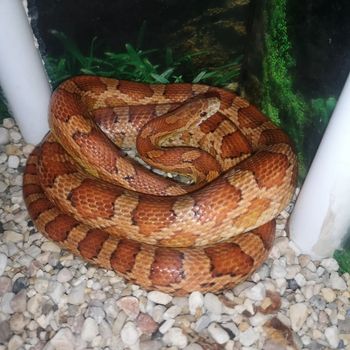 |
| 19 | Red-bellied Mud Snake (Farancia abacura) |
| 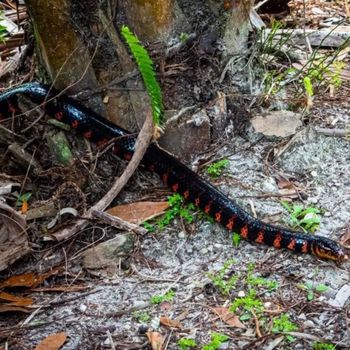 |
| 20 | Rough Green Snake (Opheodrys aestivus) |
| 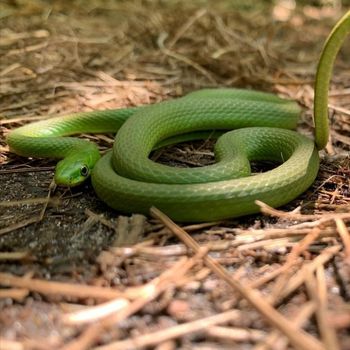 |
| 21 | Scarlet Kingsnake (Lampropeltis elapsoides) |
| 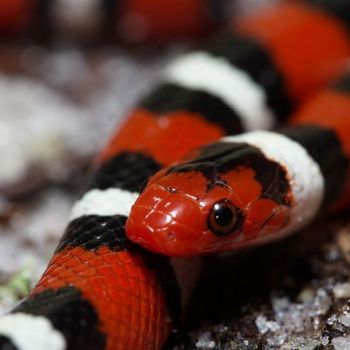 |
| 22 | Scarlet Snake (Cemophora coccinea) |
| 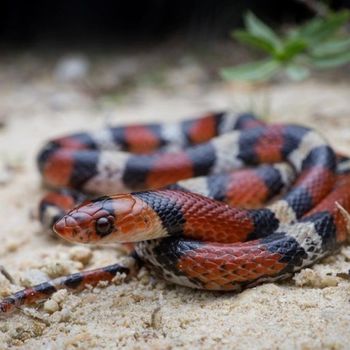 |
| 23 | Smooth Green Snake (Opheodrys vernalis) |
| 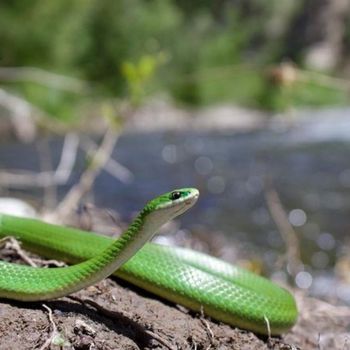 |
| 24 | Southeastern Crowned Snake (Tantilla coronata) |
| 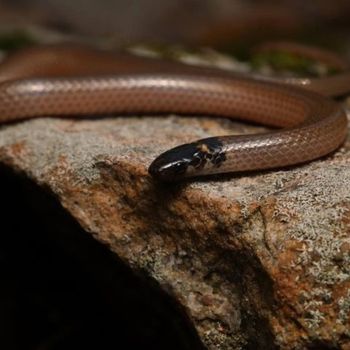 |
| 25 | Timber Rattlesnake (Crotalus horridus) |
|  |
25 Snakes You Can Find in Virginia
In the state of Virginia, a fascinating array of serpents can be found slithering through its diverse landscapes. From venomous to harmless, each species has its unique story to tell. Below, we’ll explore the wonders of these often misunderstood creatures of Virginia, from their natural habitats and behaviors to the challenges they face in our changing world.
1. Brown Water Snake
- Scientific Name: Lycodonomorphus rufulus
- Common Name: Brown water snake
- Size: Up to 2.6 feet (0.8 meters)
- Natural Habitat: Aquatic habitats, such as streams, ponds, and marshes
- Color: Brown with darker bands and a yellow belly
- Habitat: Aquatic habitats, such as streams, ponds, and marshes
- Maximum Size: Up to 2.6 feet (0.8 meters)
- Diet: Fish, frogs, and tadpoles
- Reproduction: Lay eggs in clutches of around 9-11
- Venom: Non-venomous
- Conservation: Least concern
The Lycodonomorphus rufulus, commonly known as the Brown Water Snake, can grow up to 2.6 feet in length. It is characterized by its brown coloring, darker bands, and a yellow belly. The snake that calls Virginia its home predominantly inhabits aquatic environments such as streams, ponds, and marshes. Although nocturnal and terrestrial, it is often found basking on rocks and logs during daytime. Its diet mainly consists of fish, frogs, and tadpoles. The snake lays eggs in clutches of 9-11, is non-venomous, and is considered to have a conservation status of least concern.
2. Dekay’s Brownsnake
- Scientific Name: Storeria dekayi
- Common Name: Dekay’s brown snake
- Size: 9-15 inches (23-38 cm)
- Natural Habitat: Forests, grasslands, wetlands, and urban areas
- Color: Brown or gray with dark spots
- Habitat: Forests, grasslands, wetlands, and urban areas
- Maximum Size: 9-15 inches (23-38 cm)
- Diet: Earthworms, slugs, and other soft-bodied invertebrates
- Reproduction: Give birth to live young (ovoviviparous), 3-40 offspring
- Venom: Non-venomous
- Conservation: Least concern
Storeria dekayi, commonly known as Dekay’s Brown Snake, is a small, non-venomous reptile, measuring 9-15 inches (23-38 cm) in length. Its brown or gray body features dark spots, and it inhabits forests, grasslands, wetlands, and urban areas. Exhibiting terrestrial, nocturnal, and secretive behavior, its diet consists primarily of earthworms, slugs, and other soft-bodied invertebrates. A fascinating ovoviviparous species, Dekayís Brown Snake gives birth to live young, bearing 3-40 offspring. Its current conservation status is classified as least concern.
3. Eastern Black Kingsnake
- Scientific Name: Lampropeltis nigra
- Common Name: Eastern black kingsnake
- Size: Up to 4 feet (1.22 meters)
- Natural Habitat: Forests, fields, and wetlands
- Color: Solid black with glossy scales
- Habitat: Forests, fields, and wetlands
- Maximum Size: Up to 4 feet (1.22 meters)
- Diet: Rodents, birds, amphibians, and other snakes
- Reproduction: Lay eggs in clutches of 3-24
- Venom: Non-venomous
- Conservation: Least concern
The Eastern Black Kingsnake (Lampropeltis nigra) is a non-venomous species that can grow up to 4 feet (1.22 meters) in length. This snake is characterized by its solid black coloration and glossy scales. Commonly found in forests, fields, and wetlands, it is mainly a nocturnal and terrestrial creature. Its diet consists of rodents, birds, amphibians, and other snakes. Females lay eggs in clutches of 3-24, and the species has a conservation status of ‘Least Concern.’
4. Eastern Copperhead
- Scientific Name: Agkistrodon contortrix
- Common Name: Eastern copperhead
- Size: Up to 3 feet (90 centimeters)
- Natural Habitat: Forests, swamps, and river bottoms
- Color: Reddish-brown with hourglass-shaped bands
- Habitat: Forests, swamps, and river bottoms
- Maximum Size: Up to 3 feet (90 centimeters)
- Diet: Small rodents, birds, frogs, and insects
- Reproduction: Live-bearing, 2-18 young per litter
- Venom: Venomous, hemotoxic venom
- Conservation: Least concern
The Eastern Copperhead (Agkistrodon contortrix) is a venomous snake that can grow up to 3 feet (90cm) in length. Its distinctive reddish-brown body features hourglass-shaped bands and prefers habitats such as forests, swamps, and river bottoms of Virginia. These nocturnal, terrestrial creatures primarily feed on small rodents, birds, frogs, and insects. Eastern Copperheads are live-bearing, with litters ranging from 2-18 young. Their hemotoxic venom can be dangerous, but their conservation status is considered least concern.
5. Eastern Garter Snake
- Scientific Name: Thamnophis sirtalis sirtalis
- Common Name: Eastern garter snake
- Size: Up to 2-4.5 feet (0.6-1.4 meters)
- Natural Habitat: Forests, grasslands, wetlands, and urban areas
- Color: Brown, green or gray with three yellow stripes
- Habitat: Forests, grasslands, wetlands, and urban areas
- Maximum Size: Up to 2-4.5 feet (0.6-1.4 meters)
- Diet: Earthworms, amphibians, fish, and small mammals
- Reproduction: Lay eggs in clutches of 10-40
- Venom: Mildly venomous but harmless to humans
- Conservation: Least concern
The Eastern Garter Snake (Thamnophis sirtalis sirtalis) is a commonly found snake species that can grow up to 2-4.5 feet (0.6-1.4 meters) in length. It displays a brown, green, or gray coloration adorned with three yellow stripes. Inhabitants of forests, grasslands, wetlands and urban areas, these diurnal and terrestrial reptiles primarily feed on earthworms, amphibians, fish, and small mammals. Eastern Garter Snakes reproduce by laying 10-40 eggs per clutch, and although they are mildly venomous, their venom poses little risk to humans. They are currently classified under the least concern category in conservation status.
6. Eastern Glossy Swamp Snake
- Scientific Name: Miriamausia oligospila
- Common Name: Eastern glossy swamp snake
- Size: Up to 30 inches (76 cm)
- Natural Habitat: Swamps, wetlands, and forests
- Color: Glossy black or dark brown with white spots
- Habitat: Swamps, wetlands, and forests
- Maximum Size: Up to 30 inches (76 cm)
- Diet: Frogs, fish, and tadpoles
- Reproduction: Lays up to 12 eggs in a clutch
- Venom: Mildly venomous, not dangerous to humans
- Conservation: Not assessed for conservation status
Miriamausia oligospila, commonly known as the Eastern Glossy Swamp Snake, is a mildly venomous reptile reaching up to 30 inches (76 cm) in length. With a glossy black or dark brown body adorned with white spots, this nocturnal and secretive snake inhabits swamps, wetlands, and forests. Preying primarily on frogs, fish, and tadpoles, it lays up to 12 eggs per clutch during reproduction. Though its venom poses no significant threat to humans, its conservation status remains unassessed.
7. Eastern Hog-nosed Snake
- Scientific Name: Heterodon platirhinos
- Common Name: Eastern hog-nosed snake
- Size: 20-33 inches (51-84 cm)
- Natural Habitat: Woodlands, grasslands, and sandy areas
- Color: Highly variable, typically brown or gray with dark blotches
- Habitat: Woodlands, grasslands, and sandy areas
- Maximum Size: 20-33 inches (51-84 cm)
- Diet: Mostly toads, but also other amphibians and small mammals
- Reproduction: Lay eggs, 4-60 per clutch
- Venom: Mild venom, harmless to humans
- Conservation: Least concern
The Eastern Hog-nosed Snake (Heterodon platirhinos) is a moderately-sized serpent, reaching lengths of 20-33 inches (51-84 cm). Its coloration is highly variable, typically exhibiting brown or gray hues with dark blotches. Inhabiting woodlands, grasslands, and sandy areas, this diurnal snake is known for playing dead when threatened. Its diet mainly consists of toads, along with other amphibians and small mammals. It reproduces by laying 4-60 eggs per clutch, has mild venom harmless to humans, and is classified as of “Least Concern” in conservation efforts.
8. Eastern Kingsnake
- Scientific Name: Lampropeltis getula
- Common Name: Eastern kingsnake
- Size: Up to 4 feet (1.2 meters)
- Natural Habitat: Forests, wetlands, grasslands, and suburban areas
- Color: Black or dark brown with white or yellow bands
- Habitat: Forests, wetlands, grasslands, and suburban areas
- Maximum Size: Up to 4 feet (1.2 meters)
- Diet: Small mammals, birds, reptiles, and amphibians
- Reproduction: Lay eggs in clutches of 3-24
- Venom: Non-venomous
- Conservation: Least concern
The Eastern Kingsnake (Lampropeltis getula) is a non-venomous snake, reaching up to 4 feet (1.2 meters) long. Its black or dark brown body features white or yellow bands. Commonly found in forests, wetlands, grasslands, and suburban areas, these diurnal and terrestrial snakes are known for their diverse diet, feeding on small mammals, birds, reptiles, and amphibians. Eastern Kingsnakes reproduce by laying clutches of 3-24 eggs. They are relatively unthreatened, maintaining a conservation status of “Least Concern.”
9. Eastern Milksnake
- Scientific Name: Lampropeltis triangulum
- Common Name: Eastern milksnake
- Size: Up to 3.9 feet (1.2 meters)
- Natural Habitat: Forests, grasslands, farmlands, and rocky areas
- Color: Reddish-brown with y-shaped black-edged white bands
- Habitat: Forests, grasslands, farmlands, and rocky areas
- Maximum Size: Up to 3.9 feet (1.2 meters)
- Diet: Rodents, small birds, and reptiles
- Reproduction: Lay eggs in clutches of 3-20
- Venom: Non-venomous
- Conservation: Least concern
The Eastern Milksnake (Lampropeltis triangulum) is a non-venomous snake that grows up to 3.9 feet (1.2 meters) in length. It features a reddish-brown color adorned with Y-shaped black-edged white bands. Commonly found in forests, grasslands, farmlands, and rocky areas of Virginia, this nocturnal and terrestrial snake primarily consumes rodents, small birds, and reptiles. Eastern Milksnakes reproduce by laying egg clutches of 3-20. Currently, their conservation status is listed as least concern.
10. Eastern Rat Snake
- Scientific Name: Pantherophis alleghaniensis
- Common Name: Eastern rat snake
- Size: Up to 7 feet (2.1 meters)
- Natural Habitat: Forests, meadows, wetlands, and urban areas
- Color: Black or dark gray with pale gray, tan, or yellow
- Habitat: Forests, meadows, wetlands, and urban areas
- Maximum Size: Up to 7 feet (2.1 meters)
- Diet: Rodents, birds, and bird eggs
- Reproduction: Lay eggs in clutches of 5-27
- Venom: Non-venomous
- Conservation: Least concern
The Eastern Rat Snake (Pantherophis alleghaniensis) is a large, non-venomous reptile that can reach 7 feet (2.1 meters) in length. They have a black or dark gray color with patches of pale gray, tan, or yellow. Found in forests, meadows, wetlands, and urban areas, these semi-arboreal snakes have diurnal or nocturnal behavior depending on temperature. Their diet consists of rodents, birds, and bird eggs. Eastern Rat Snakes reproduce by laying eggs in clutches of 5-27 and have a conservation status marked as “Least Concern.”
11. Eastern Ribbon Snake
- Scientific Name: Thamnophis sauritus sauritus
- Common Name: Eastern ribbon snake
- Size: 18-34 inches (45-86 cm)
- Natural Habitat: Wetlands, swamps, and marshes near water
- Color: Black, greenish, or brown with three distinct light stripes
- Habitat: Wetlands, swamps, and marshes near water
- Maximum Size: 18-34 inches (45-86 cm)
- Diet: Frogs, toads, small fish, and insects
- Reproduction: Lay 3-27 eggs, sometimes communal with other snakes
- Venom: Non-venomous
- Conservation: Least concern
The Eastern Ribbon Snake, scientifically known as Thamnophis sauritus sauritus, is a non-venomous reptile measuring 18-34 inches (45-86 cm). It inhabits wetlands, swamps, and marshes near water and features a distinctive black, greenish, or brown color with three light stripes. Known for their daytime activity and skittish behavior, these snakes are excellent swimmers with a diet comprising frogs, toads, small fish, and insects. They reproduce by laying 3-27 eggs, sometimes communally with other snakes. Their conservation status is of least concern.
12. Northern Cottonmouth
- Scientific Name: Agkistrodon piscivorus
- Common Name: Northern cottonmouth
- Size: Up to 4 feet (1.2 meters)
- Natural Habitat: Swamps, marshes, streams, and rivers
- Color: Dark brown or black with faint banding
- Habitat: Swamps, marshes, streams, and rivers
- Maximum Size: Up to 4 feet (1.2 meters)
- Diet: Fish, amphibians, and small mammals
- Reproduction: Live bearing, giving birth to 1-16 young
- Venom: Venomous, hemotoxic venom
- Conservation: Least concern
The Northern Cottonmouth (Agkistrodon piscivorus) is a dark brown or black venomous snake, reaching up to 4 feet (1.2 meters). It features faint banding and inhabits swamps, marshes, streams, and rivers. As a semi-aquatic, nocturnal, and aggressive creature, it primarily preys on fish, amphibians, and small mammals. This snake is live-bearing, producing litters of 1-16 young. Its hemotoxic venom is potent but poses a low risk to humans, as it is classified under the least concern conservation status.
13. Northern Water Snake
- Scientific Name: Nerodia sipedon
- Common Name: Northern water snake
- Size: Up to 4.5 feet (1.4 meters)
- Natural Habitat: Aquatic habitats, such as rivers, lakes, ponds, and marshes
- Color: Brown or gray with dark bands or blotches
- Habitat: Aquatic habitats, such as rivers, lakes, ponds, and marshes
- Maximum Size: Up to 4.5 feet (1.4 meters)
- Diet: Fish, amphibians, and invertebrates
- Reproduction: Lay eggs in clutches of 10-30
- Venom: Non-venomous
- Conservation: Least concern
The Northern Water Snake (Nerodia sipedon) is a non-venomous reptile that can grow up to 4.5 feet (1.4 meters) in length. It is characterized by its brown or gray color with dark bands or blotches. This nocturnal and semi-aquatic species can be found in a variety of aquatic habitats, including rivers, lakes, ponds, and marshes. Its diet consists of fish, amphibians, and invertebrates. Northern Water Snakes reproduce by laying eggs in clutches of 10-30, and currently have a conservation status of least concern.
14. Pine Snake
- Scientific Name: Pituophis melanoleucus
- Common Name: Pine snake
- Size: Up to 7 feet (2.1 meters)
- Natural Habitat: Forests, fields, and sandy areas
- Color: Cream, tan, or gray with dark splotches
- Habitat: Forests, fields, and sandy areas
- Maximum Size: Up to 7 feet (2.1 meters)
- Diet: Rodents and other small mammals, occasionally birds and eggs
- Reproduction: Lay eggs in clutches of 3-24
- Venom: Non-venomous
- Conservation: Least concern
The Pine Snake (Pituophis melanoleucus) is a large, non-venomous reptile that can reach up to 7 feet (2.1 meters) in length. Its primary colors include cream, tan, and gray with dark splotches. Native to forests, fields, and sandy areas, they are primarily terrestrial and fossorial creatures. Pine Snakes feed on rodents and small mammals, and occasionally birds and eggs. They reproduce by laying egg clutches, consisting of 3-24 eggs. Pine Snake’s conservation status is listed as least concern.
15. Plain-bellied Watersnake
- Scientific Name: Nerodia erythrogaster
- Common Name: Plain-bellied watersnake
- Size: 24-40 inches (61-102 cm)
- Natural Habitat: Rivers, lakes, ponds, and wetlands
- Color: Olive, brown, or gray with a yellow, orange, or red unmarked belly
- Habitat: Rivers, lakes, ponds, and wetlands
- Maximum Size: 24-40 inches (61-102 cm)
- Diet: Fish, frogs, and other amphibians
- Reproduction: Live-bearing; 5-29 offspring per litter
- Venom: Non-venomous
- Conservation: Least concern
The Plain-bellied Watersnake (Nerodia erythrogaster) is a semi-aquatic, non-venomous snake measuring 24-40 inches (61-102 cm) in length. It features an olive, brown, or gray coloration with a distinct yellow, orange, or red unmarked belly. As adept swimmers, they inhabit rivers, lakes, ponds, and wetlands, with diurnal behavior. Their diet primarily consists of fish, frogs, and other amphibians. These snakes are live-bearing, producing 5-29 offspring per litter. Currently, their conservation status is of least concern.
16. Queen Snake
- Scientific Name: Regina septemvittata
- Common Name: Queen snake
- Size: Up to 3 feet (0.9 meters)
- Natural Habitat: Streams, creeks, and other aquatic environments
- Color: Olive, brown or gray with three stripes and cream or yellowish belly
- Habitat: Streams, creeks, and other aquatic environments
- Maximum Size: Up to 3 feet (0.9 meters)
- Diet: Crayfish and other small aquatic invertebrates
- Reproduction: Lay eggs in clutches of 4-14
- Venom: Non-venomous
- Conservation: Least concern
The Queen Snake (Regina septemvittata) is a non-venomous reptile growing up to 3 feet (0.9 meters) in length. Often sporting olive, brown, or gray coloration, this snake displays three distinctive stripes and a yellowish belly. It thrives in aquatic habitats such as streams and creeks, and is highly active during the day. Queen Snakes primarily feed on crayfish and other small aquatic invertebrates. They lay eggs in clutches of 4-14, and currently face no significant conservation threats.
17. Rainbow snake
- Scientific Name: Farancia erytrogramma
- Common Name: Rainbow snake
- Size: Up to 5.5 feet (1.67 meters)
- Natural Habitat: Aquatic habitats, such as rivers, lakes, and swamps
- Color: Black with colorful red or pink stripes
- Habitat: Aquatic habitats, such as rivers, lakes, and swamps
- Maximum Size: Up to 5.5 feet (1.67 meters)
- Diet: Eels and other small fish
- Reproduction: Lay eggs in clutches of 10-20
- Venom: Non-venomous
- Conservation: Least concern
The Rainbow Snake (Farancia erytrogramma) is a colorful, non-venomous aquatic serpent, growing up to 5.5 feet (1.67 meters) in length. Boasting a sleek black body with vibrant red or pink stripes, it is commonly found in rivers, lakes, and swamps. This secretive, nocturnal snake feeds primarily on eels and other small fish. Rainbow Snakes lay eggs in clutches of 10-20, and despite their elusive nature, are considered to be of least concern in terms of conservation status.
18. Red Corn Snake
- Scientific Name: Pantherophis guttatus
- Common Name: Corn snake or red rat snake
- Size: Up to 6 feet (1.8 meters)
- Natural Habitat: Forests, grasslands, and abandoned buildings
- Color: Reddish-orange with black-bordered red blotches
- Habitat: Forests, grasslands, and abandoned buildings
- Maximum Size: Up to 6 feet (1.8 meters)
- Diet: Rodents, birds, and eggs
- Reproduction: Lay eggs in clutches of 10-30
- Venom: Non-venomous
- Conservation: Least concern
The Red Corn Snake (Pantherophis guttatus), also known as the Red Rat Snake, is a non-venomous snake species with a reddish-orange color and distinct black-bordered red blotches. It can grow up to 6 feet (1.8 meters), inhabiting various environments, including forests, grasslands, and abandoned buildings. These nocturnal, semi-arboreal creatures primarily feed on rodents, birds, and eggs. Corn snakes reproduce by laying 10-30 eggs in clutches and are currently deemed a species of least concern in conservation status.
19. Red-bellied Mud Snake
- Scientific Name: Farancia abacura
- Common Name: Red-bellied mud snake
- Size: Up to 40 inches (102 cm)
- Natural Habitat: Swamps, bogs, and slow-moving bodies of water
- Color: Black with red or pink belly
- Habitat: Swamps, bogs, and slow-moving bodies of water
- Maximum Size: Up to 40 inches (102 cm)
- Diet: Amphibians, especially salamanders
- Reproduction: Oviparous, 4-14 eggs per clutch
- Venom: Non-venomous
- Conservation: Least concern
The Red-bellied Mud Snake (Farancia abacura) is a semi-aquatic, non-venomous reptile that can grow up to 40 inches (102 cm) long. These snakes are characterized by their striking black coloration and vibrant red or pink belly. Typically found in swamps, bogs, and slow-moving bodies of water, they are nocturnal and skilled swimmers with a diet primarily consisting of amphibians, especially salamanders. Red-bellied Mud Snakes are oviparous, producing 4-14 eggs per clutch. Currently, their conservation status is listed as least concern.
20. Rough Green Snake
- Scientific Name: Opheodrys aestivus
- Common Name: Rough green snake
- Size: 22-32 inches (56-81 cm)
- Natural Habitat: Forests, grasslands, and areas near water sources
- Color: Bright green with a lighter belly
- Habitat: Forests, grasslands, and areas near water sources
- Maximum Size: 22-32 inches (56-81 cm)
- Diet: Insects and spiders
- Reproduction: Lay eggs in clutches of 3-12
- Venom: Non-venomous
- Conservation: Least concern
The Rough Green Snake (Opheodrys aestivus) is a vibrant, non-venomous reptile that measures between 22-32 inches (56-81 cm) in length. Its dazzling bright green coloration is accentuated by a lighter belly, making it well-camouflaged in its preferred habitats of forests, grasslands, and areas near water sources. Known for their diurnal, arboreal behavior, these skillful climbers of Virginia primarily consume insects and spiders. Rough Green Snakes reproduce by laying clutches of 3-12 eggs, and their conservation status is currently classified as least concern.
21. Scarlet Kingsnake
- Scientific Name: Lampropeltis elapsoides
- Common Name: Scarlet kingsnake
- Size: Up to 20 inches (50 cm)
- Natural Habitat: Forests, woodlands, and populated areas with cover
- Color: Red, black, and yellow or white bands
- Habitat: Forests, woodlands, and populated areas with cover
- Maximum Size: Up to 20 inches (50 cm)
- Diet: Small reptiles and amphibians, especially lizards and skinks
- Reproduction: Lay eggs in clutches of 3-12
- Venom: Non-venomous
- Conservation: Least concern
The Scarlet Kingsnake (Lampropeltis elapsoides) is a strikingly colored serpent, growing up to 20 inches (50 cm) long with vivid red, black, and yellow or white bands. Inhabiting forests, woodlands, and populated areas offering cover, this nocturnal and secretive snake primarily preys on small reptiles and amphibians, particularly lizards and skinks. Non-venomous and laying eggs in clutches of 3-12, the Scarlet Kingsnake is currently categorized as “least concern” in terms of conservation status.
22. Scarlet Snake
- Scientific Name: Cemophora coccinea
- Common Name: Scarlet snake
- Size: Up to 20-30 inches (50-76 cm)
- Natural Habitat: Forests, grasslands, and suburban areas
- Color: Red or orangish with black bands and a white or yellowish underbelly
- Habitat: Forests, grasslands, and suburban areas
- Maximum Size: Up to 20-30 inches (50-76 cm)
- Diet: Reptile eggs, small rodents, and lizards
- Reproduction: Lays eggs in clutches of 3-8
- Venom: Non-venomous
- Conservation: Least concern
The Scarlet Snake (Cemophora coccinea) is a non-venomous, nocturnal reptile found in forests, grasslands, and suburban areas. Measuring up to 20-30 inches (50-76 cm) in length, it features striking red or orangish scales with black bands and a white or yellowish underbelly. This burrowing snake has a diet consisting of reptile eggs, small rodents, and lizards. Females lay eggs in clutches of 3-8. With a conservation status of least concern, the Scarlet Snake continues to thrive in its habitats.
23. Smooth Green Snake
- Scientific Name: Opheodrys vernalis
- Common Name: Smooth green snake
- Size: 14-20 inches (36-51 cm)
- Natural Habitat: Grasslands, meadows, and open woodlands
- Color: Bright green with a lighter belly
- Habitat: Grasslands, meadows, and open woodlands
- Maximum Size: 14-20 inches (36-51 cm)
- Diet: Insects and spiders
- Reproduction: Lay eggs in clutches of 3-12
- Venom: Non-venomous
- Conservation: Least concern
The Smooth Green Snake (Opheodrys vernalis) measures 14-20 inches (36-51 cm) and is characterized by its vibrant green color and lighter belly. Commonly found in grasslands, meadows, and open woodlands, this diurnal and terrestrial reptile is an adept climber. Its diet mainly consists of insects and spiders. In terms of reproduction, they lay eggs in clutches of 3-12. Though non-venomous, these snakes should be admired from afar. Fortunately, their conservation status is currently listed as ‘Least Concern.’
24. Southeastern Crowned Snake
- Scientific Name: Tantilla coronata
- Common Name: Southeastern crowned snake
- Size: Up to 10 inches (25 centimeters)
- Natural Habitat: Wooded areas, under rocks, logs, or leaf litter
- Color: Blackish-brown with a yellowish-white collar
- Habitat: Wooded areas, under rocks, logs, or leaf litter
- Maximum Size: Up to 10 inches (25 centimeters)
- Diet: Centipedes, beetle larvae, and small insects
- Reproduction: Lay eggs in clutches of 2-4
- Venom: Non-venomous
- Conservation: Least concern
The Southeastern Crowned Snake (Tantilla coronata) is a small, non-venomous serpent, which measures up to 10 inches (25 cm) in length. Sporting a blackish-brown body with a distinct yellowish-white collar, these reptiles inhabit wooded areas, hiding beneath rocks, logs, and leaf litter. Characterized by their nocturnal and secretive behavior, they primarily feed on centipedes, beetle larvae, and small insects. Southeastern Crowned Snakes reproduce by laying clutches of 2-4 eggs, and their conservation status is marked as Least Concern.
25. Timber Rattlesnake
- Scientific Name: Crotalus horridus
- Common Name: Timber rattlesnake
- Size: Up to 6 feet (1.8 meters)
- Natural Habitat: Forests, mixed woodlands, and rocky hillsides
- Color: Yellow, brown, gray, or black with dark bands
- Habitat: Forests, mixed woodlands, and rocky hillsides
- Maximum Size: Up to 6 feet (1.8 meters)
- Diet: Rodents, birds, and small mammals
- Reproduction: Viviparous, giving birth to 4-14 live young
- Venom: Hemotoxic venom
- Conservation: Least concern
The Timber Rattlesnake, scientifically known as Crotalus horridus, is a solitary, ambush predator that can grow up to 6 feet (1.8 meters) in length. It comes in various colors, including yellow, brown, gray, or black with dark bands, and inhabits forests, mixed woodlands, and rocky hillsides. Its diet consists of rodents, birds, and small mammals. Unlike most snakes, the Timber Rattlesnake is viviparous, giving birth to 4-14 live young. It possesses hemotoxic venom, and its conservation status is currently listed as least concern.
Nearby States:
Final Words
All the 25 snakes have truly opened our eyes to the fascinating world of snakes found in Virginia. Who knew there were so many different types of these slithering reptiles, each with their own unique characteristics and habitats?
Not only did we get a chance to learn about some of the more common and well-known species, but we also delved into the lesser-known and often misunderstood ones.
So, the next time you’re out and about in Virginia, keep an eye out for these incredible creatures, and let’s continue to appreciate and protect the diverse wildlife that makes our world so interesting!
Are the types of snakes found in Virginia and New York similar?
Yes, the types of snakes found in Virginia and New York are quite similar. Both states are home to a variety of snake species, including the eastern garter snake, black rat snake, and northern copperhead. So, if you’re interested in snakes in new york, you’ll find some familiar species in Virginia as well.

